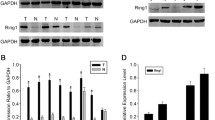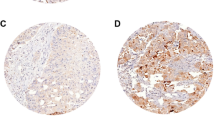Abstract
Ring finger protein 1 (RING1) have recently been reported to be related to aggressive tumor features in Prostate Cancer and urothelial carcinoma of the bladder. However, the role of RING1 in non-small-cell lung cancer (NSCLC) tumorigenesis has never been elucidated. So we aimed at investigating the potential role of RING1 in NSCLC. RING1 expression was evaluated by Immunoblot in 8 paired fresh lung cancer tissues and immunohistochemistry on 69 paraffin-embedded sections from 2006 to 2009. Furthermore, flow-cytometry and RNA interference were performed to analyse the role of RING1 in A549 cells. We showed that the expression level of RING1 was significant increased in lung cancer as compared with the adjacent normal tissue. High expression level of RING1 was associated with TNM stage (P = 0.013), and RING1 was positively related with proliferation marker Ki67 (P < 0.05). Moreover, RING1 knockdown induces growth suppression of human lung cancer cells through G1/S cell cycle phase arrest in vitro. Kaplan–Meier survival curves showed that high expression level of RING1 was associated with poor prognosis (P = 0.03). On the basis of these results, we suggested that RING1 protein expression may be a favorable independent prognostic parameter for non-small cell lung cancer.





Similar content being viewed by others
Abbreviations
- NSCLC:
-
Non-small cell lung cancer
- PcG:
-
Poly-comb group
- CDK2:
-
Cyclin-dependent kinase 2
- GWAS:
-
Genome-wide association studies
References
Buchenau P, Hodgson J, Strutt H, Arndt-Jovin DJ (1998) The distribution of poly-comb-group proteins during cell division and development in Drosophila embryos: impact on models for silencing. J Cell Biol 141(2):469–481
Caldas C, Aparicio S (1999) Cell memory and cancer–the story of the trithorax and Poly-comb group genes. Cancer Metastasis Rev 18(2):313–329
Cao R, Wang L, Wang H, Xia L, Erdjument-Bromage H, Tempst P et al (2002) Role of histone H3 lysine 27 methylation in Poly-comb-group silencing. Science 298(5595):1039–1043
Cao W, Ribeiro Rde O, Liu D, Saintigny P, Xia R, Xue Y et al (2012) EZH2 promotes malignant behaviors via cell cycle dysregulation and its mRNA level associates with prognosis of patient with non-small cell lung cancer. PLoS One 7(12):e52984
Cooper CS, Foster CS (2009) Concepts of epigenetics in prostate cancer development. Br J Cancer 100(2):240–245
Czermin B, Melfi R, McCabe D, Seitz V, Imhof A, Pirrotta V (2002) Drosophila enhancer of Zeste/ESC complexes have a histone H3 methyltransferase activity that marks chromosomal Poly-comb sites. Cell 111(2):185–196
Dimri GP, Martinez JL, Jacobs JJ, Keblusek P, Itahana K, Van Lohuizen M et al (2002) The Bmi-1 oncogene induces telomerase activity and immortalizes human mammary epithelial cells. Cancer Res 62(16):4736–4745
Ferraiuolo MA, Rousseau M, Miyamoto C, Shenker S, Wang XQ, Nadler M et al (2010) The three-dimensional architecture of Hox cluster silencing. Nucleic Acids Res 38(21):7472–7484
Fussbroich B, Wagener N, Macher-Goeppinger S, Benner A, Falth M, Sultmann H et al (2011) EZH2 depletion blocks the proliferation of colon cancer cells. PLoS One 6(7):e21651
Goebl MG (1991) The bmi-1 and mel-18 gene products define a new family of DNA-binding proteins involved in cell proliferation and tumorigenesis. Cell 66(4):623
Hinz S, Kempkensteffen C, Christoph F, Krause H, Schrader M, Schostak M et al (2008) Expression parameters of the poly-comb group proteins BMI1, SUZ12, RING1 and CBX7 in urothelial carcinoma of the bladder and their prognostic relevance. Tumour Biol 29(5):323–329
Jacobs JJ, Scheijen B, Voncken JW, Kieboom K, Berns A, van Lohuizen M (1999) Bmi-1 collaborates with c-Myc in tumorigenesis by inhibiting c-Myc-induced apoptosis via INK4a/ARF. Genes Dev 13(20):2678–2690
Jemal A, Siegel R, Xu J, Ward E (2010) Cancer statistics, 2010. CA Cancer J Clin 60(5):277–300
Ke Q, Ji J, Cheng C, Zhang Y, Lu M, Wang Y et al (2009) Expression and prognostic role of Spy1 as a novel cell cycle protein in hepatocellular carcinoma. Exp Mol Pathol 87(3):167–172
Kerr KM (2013) Clinical relevance of the new IASLC/ERS/ATS adenocarcinoma classification. J Clin Pathol 66(10):832–8
Kovalchuk O, Tryndyak VP, Montgomery B, Boyko A, Kutanzi K, Zemp F et al (2007) Estrogen-induced rat breast carcinogenesis is characterized by alterations in DNA methylation, histone modifications and aberrant micro-RNA expression. Cell Cycle 6(16):2010–2018
Li H, Bitler BG, Vathipadiekal V, Maradeo ME, Slifker M, Creasy CL et al (2012) ALDH1A1 is a novel EZH2 target gene in epithelial ovarian cancer identified by genome-wide approaches. Cancer Prev Res (Phila) 5(3):484–491
Li Z, Qu L, Dong Q, Huang B, Li H, Tang Z et al (2012) Over-expression of CARMA3 in non-small-cell lung cancer is linked for tumor progression. PLoS One 7(5):e36903
Lu, C., Liu, G., Cui, X., Zhang, J., Wei, L., Wang, Y., et al. (2013). Expression of SGTA Correlates with Prognosis and Tumor Cell Proliferation in Human Hepatocellular Carcinoma. Pathol Oncol Res
Mathers CD, Loncar D (2006) Projections of global mortality and burden of disease from 2002 to 2030. PLoS Med 3(11):e442
Qin H, Wang J, Liang Y, Taniguchi Y, Tanigaki K, Han H (2004) RING1 inhibits transactivation of RBP-J by Notch through interaction with LIM protein KyoT2. Nucleic Acids Res 32(4):1492–1501
Raaphorst FM, Meijer CJ, Fieret E, Blokzijl T, Mommers E, Buerger H et al (2003) Poorly differentiated breast carcinoma is associated with increased expression of the human poly-comb group EZH2 gene. Neoplasia 5(6):481–488
Raaphorst FM, Vermeer M, Fieret E, Blokzijl T, Dukers D, Sewalt RG et al (2004) Site-specific expression of poly-comb-group genes encoding the HPC-HPH/PRC1 complex in clinically defined primary nodal and cutaneous large B-cell lymphomas. Am J Pathol 164(2):533–542
Satijn DP, Otte AP (1999) RING1 interacts with multiple Poly-comb-group proteins and displays tumorigenic activity. Mol Cell Biol 19(1):57–68
Satijn DP, Gunster MJ, van der Vlag J, Hamer KM, Schul W, Alkema MJ et al (1997) RING1 is associated with the poly-comb group protein complex and acts as a transcriptional repressor. Mol Cell Biol 17(7):4105–4113
Satijn DP, Olson DJ, van der Vlag J, Hamer KM, Lambrechts C, Masselink H et al (1997) Interference with the expression of a novel human poly-comb protein, hPc2, results in cellular transformation and apoptosis. Mol Cell Biol 17(10):6076–6086
Shin YJ, Kim JH (2012) The role of EZH2 in the regulation of the activity of matrix metalloproteinases in prostate cancer cells. PLoS One 7(1):e30393
Travis WD, Brambilla E, Muller-Hermelink HK et al (2004) World Health Organisation Classification of Tumors. Pathology and Genetics of tumors of the lung. Thymus and Heart, p 1
van Leenders GJ, Dukers D, Hessels D, van den Kieboom SW, Hulsbergen CA, Witjes JA et al (2007) Poly-comb-group oncogenes EZH2, BMI1, and RING1 are over-expressed in prostate cancer with adverse pathologic and clinical features. Eur Urol 52(2):455–463
Wang Y, Fei M, Cheng C, Zhang D, Lu J, He S et al (2008) Jun activation domain-binding protein 1 negatively regulate p27 kip1 in non-Hodgkin’s lymphomas. Cancer Biol Ther 7(3):460–467
Wang Y, Yang S, Ni Q, He S, Zhao Y, Yuan Q et al (2012) Over-expression of forkhead box J2 can decrease the migration of breast cancer cells. J Cell Biochem 113(8):2729–2737
Watanabe H, Soejima K, Yasuda H, Kawada I, Nakachi I, Yoda S et al (2008) Deregulation of histone lysine methyltransferases contributes to oncogenic transformation of human bronchoepithelial cells. Cancer Cell Int 8:15
Xu X, Yamamoto H, Sakon M, Yasui M, Ngan CY, Fukunaga H et al (2003) Over-expression of CDC25A phosphatase is associated with hyper-growth activity and poor prognosis of human hepatocellular carcinomas. Clin Cancer Res 9(5):1764–1772
Zhang Y, Peng C, Wu G, Wang Y, Liu R, Yang S et al (2011) Expression of NLK and its potential effect in ovarian cancer chemotherapy. Int J Gynecol Cancer 21(8):1380–1387
Acknowledgments
This work was supported by the National Natural Scientific Foundation of China (no. 81272708).
Conflict of interest
None.
Author information
Authors and Affiliations
Corresponding authors
Additional information
Yiqun Zhou and Chunhua Wan contributed equally to this work.
Rights and permissions
About this article
Cite this article
Zhou, Y., Wan, C., Liu, Y. et al. Polycomb Group Oncogene RING1 is Over-expressed in Non-Small Cell Lung Cancer. Pathol. Oncol. Res. 20, 549–556 (2014). https://doi.org/10.1007/s12253-013-9727-9
Received:
Accepted:
Published:
Issue Date:
DOI: https://doi.org/10.1007/s12253-013-9727-9




